

Instructions for building a garden pond
There are a number of ways to integrate water into your garden design. A water feature in the centre, a stream running right through it or a generously sized garden pond that invites us to swim in the summer. Created with your own hands, a garden pond like this is twice as much fun in the end. To make the project a success, I'll give you a few tips for planning and building the garden pond.
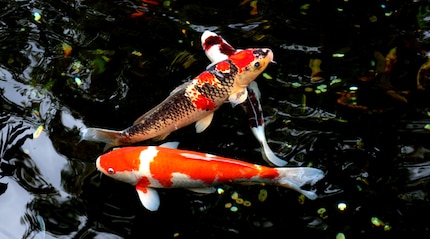
First of all, it is important to know why you want to build a pond. Do you want a pond with lots of colourful fish, water-spouting figures or water features and, if possible, artificial lighting? Or do you want to bring a little piece of nature into your garden with the garden pond by creating a biotope of water and plants in which native animals and plants feel at home?
These questions are very important when planning a garden pond. You should also be clear about the location of the pond:
- Will the pond receive sunlight all day or are there trees in the immediate vicinity that will shade the pond? - Is the pond covered with a lot of leaves from shrubs and trees in autumn, which need to be removed from the pond or because of which you need to stretch a net? - Are you planning to plant water lilies? If so, the water depth must be at least 80-120 cm.
General rule for a beautiful and well-functioning pond: The sunnier, the more beautiful the pond and the aquatic and marsh plants in it will develop.

What do I need to consider when designing the garden pond?
The shape and design of the pond play an important role when planning it. It is therefore important to answer the following questions:
- Is our space limited?
- Should our pond consist of a tub or a larger basin?
- Are we planning to integrate our pond into the existing landscape?
- Would we like a swimming pond in addition to our water biotope, where we can cool off on hot summer days?
Many things are possible, which is why it is all the more important to clarify your needs and take the existing space and location into account. Basically, there is a place for a small pond with a mini water lily in every garden, no matter how small.
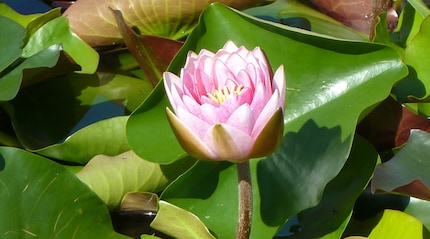
Mini water lily in a tub
Small and mini ponds
The easiest and probably cheapest way to create a small pond is to use existing oak barrels or other watertight containers. These can be discarded rain barrels, bathtubs, well troughs or metal containers, for example. These are placed in a sunny location or buried directly at ground level in the garden. Of course, we also need to give our mini pond the sunniest spot in our garden.
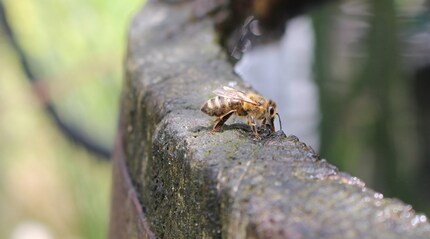
Tub filled with water
Prefabricated ponds made from prefabricated plastic tubs
For smaller ponds, ready-moulded plastic pond trays are an easy way to build a pond. These prefabricated ponds are very easy to use and are embedded in the ground using a pit. Once embedded, you need to take care when filling the cavities with sand around the plastic tray. This ensures that the pond tray is correctly levelled and dug in horizontally. Once it is correctly positioned, you can fill the tray halfway with water. This allows you to check the level and the horizontal again. You can then carefully fill in the remaining cavities with sand using a garden hose.
Planting is easy. In most cases, the bank and sump zones of these plastic trays are already built into the tray and make planting easier. If desired, additional artificial streams can also be installed here. These are also available as prefabricated moulds.
Procedure for pond construction with liner and composite mat
The most efficient way to build larger ponds is with a pond liner and composite mat. The composite mat on the pond liner ensures that the liner lasts for many years. It is best to order the pond liner from a company that delivers the sheets to you welded together. This is easier and safer. We also need pond fleece, which is laid out before the pond liner is installed.
For smaller ponds, you can also cut the pond liner to size yourself and glue it together depending on the size. You will need glue, a brush, a heat-resistant base, a sturdy roller to press the liner onto and a hot air blower to dry the glue. My advice here is to find out in advance from a specialist retailer what additional materials are needed and what the exact procedure is.

Finishing work on a smaller pond
How do I calculate the material required for a liner pond?
We use a garden hose to calculate the length and width of the pond liner required after excavating the pond trough. Due to the weight of the hose, it can be easily laid out over the various steps in the pond and around the pond. You can then simply spread it out on the lawn and measure it with a metre. An additional 30 cm is needed all round for the finish. It is best to plan an overhang over the banks and add 60 cm all round. If you weld the film yourself, a further 5 cm will be lost due to the welding. You should also take this into account.
Procedure for laying the pond liner
- The first step is to lay the pond liner on the excavated bottom of the pit. - Only then is the pond liner spread out on the pond substrate without creases and as close as possible to the various steps, without creases and flush.
- The third step is to lay the composite mat on the liner and only glue it to the pond liner at the end. For a deep pond, we recommend installing safety steps every 50 cm. Sandbags are placed on top of these. This provides a better grip and helps prevent the pond liner and composite mat from slipping.
- The next step is to glue the individual composite mats together using a hot air blower to eliminate any creases. The result is a smooth and wrinkle-free surface that is now ready for the mortar layer to be installed.
- In a final step, the mortar layer is applied to the composite mat. For smaller ponds, a layer of gravel and sand can be applied to the base of the pond instead of the mortar layer.
The transition from the pond to the bank is covered with slabs or gravel and larger stones. If you get the impression that the liner pond is leaking, first check whether water is being lost from the pond through the capillary effect of a fold in the liner. However, it also often happens that part of a plant root stands in the pond and thus draws water out of the pond.

Technical features of a pond
Of course, when building a pond, the inflow and outflow of water must also be guaranteed. This can be done underground or via an above-ground garden hose. It is also worth considering whether a stream system should be embedded in addition to the pond. To maintain the biological balance in the garden pond, it is advisable to install a filter system and a pond pump. This is essential as soon as fish swim in the pond.
As building a garden pond is not an everyday project, it is worth contacting a specialist for advice before or during the planning phase. This will help you to avoid major mistakes.
How do I plant my pond?
There are many different plants for in and around the water. Here we distinguish between the following groups of plants and uses:
- Water plants
- Marsh plants
- Plants for wet zones
- Plants for dry border zones
The individual plant groups are briefly described below
Water plants
One of the best-known aquatic plants is the water lily. Water lilies need a water level of at least 80-120 cm to flower. However, there are also aquatic plants that only need a water depth of 30-50 cm.
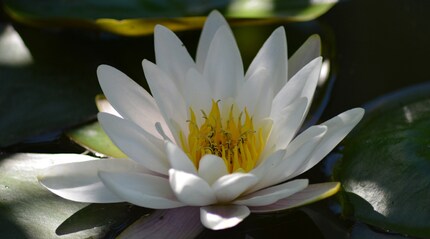
White water lily
Marsh plants
In addition to aquatic plants, which mostly inhabit the open water, it is mainly the marsh inhabitants that fascinate observers and enthusiasts. These plants can thrive both in the water and in the shore zone. They are very adaptable and true survival artists. The ideal water depth for marsh plants is 5-10 cm. The water iris or broad-leaved bulrush is one of the best-known marsh pond plants that we probably know.
Plants for wetlands
This is the name given to plants that thrive on the banks of streams or in wet meadows. These include marsh marigold, purple loosestrife and purple loosestrife, greater and lesser valerian, water euphorbia, meadowsweet and water mint. All these plants are characterised by their ability to tolerate temporary dryness as well as the wetness of a flooded wet meadow. They often have their feet in the water. However, the rest of the plant grows on a dry embankment. If the plant zone around the garden pond is varied, they are a very attractive addition to the bank zone.
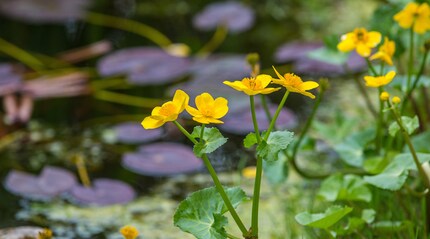
Marsh marigold at the edge of a pond
Plants for the dry edge and transition zone
In a garden, the edge of a pond usually merges into existing flower borders and shrub beds. This transition is demarcated with slabs, walls or a gravel and crushed stone bed. To prevent this transition from looking bare, smaller, hardy perennials are planted here for a dry location. All plants for the rock garden are suitable here. Thyme, rock garden carnations, stonecrops and flowering cushions can develop optimally here. It is worth placing a seat - such as a bench - on this sand and gravel bench. From here, you can observe the garden pond and the buzzing and croaking life around it at any time.

I could go on and on about the garden pond and its flora and fauna. It's a wonderful addition to any garden or balcony. Be it just in a discarded oak barrel or in an old washtub. It's fascinating all the same!
Of course, if you have more space available, you should definitely build your own water paradise in the garden. With this in mind: have fun and success building and enjoying your own pond!
You might be interested in these products:
I discovered my love for gardening very early on and later turned my passion into my profession. For a few years now, I’ve been regularly writing blog posts and publishing articles in the HomeGardening section of myPfadFinder.com. This is where I give readers tips and tricks on gardens and balconies and present my latest gardening videos.
Find out more about me here: <a href="http://www.andreas-homegardening.com/" target="_blank">www.andreas-homegardening.com</a>
Interesting facts about products, behind-the-scenes looks at manufacturers and deep-dives on interesting people.
Show all
